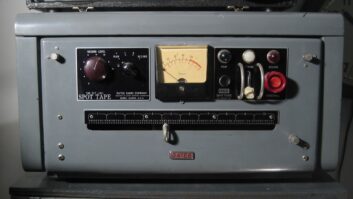Virtual reality appliances, Alexa and self-driving cars gobbled up the spotlight at CES 2017, the consumer electronics show held this winter. Here are three radio-related items that might have slipped past you.
IHEART EXPANDS OFFERINGS
Industry biggie iHeartRadio is offering paid iterations of its streaming music service, competing more directly with Apple and Spotify. It positions these new offerings as the first to add “on-demand functionality and interactivity to live radio.”

iHeartRadio says its new paid streaming services add on-demand functionality and interactivity to live radio. Note the replay button at bottom.
A notable feature is a “replay” function that lets a listener replay a song he or she just heard on a live radio stream.
At CES, the company officially launched “iHeartRadio Plus” and “iHeartRadio All Access Powered by Napster,” aimed at desktop and mobile computing platforms. It had previewed these services last fall.
For $4.99 a month, iHeartPlus subscribers can replay any song they hear on any iHeart audio stream and save it to their own playlist for extra listens later. The Plus service also lets subscribers skip as many songs as they want on the company’s custom Artist Stations, and search and play music from an online library that promises millions of tracks.
For $9.99 a month, iHeartRadio All Access Powered by Napster includes the same features plus a personal music collection and library linked to radio content. The user can build his or her own personal music library. There is no playback cap, and the user can reorder, delete and sequence a playlist and manage unlimited playlists.
The free version of iHeartRadio, which launched in 2011, also continues to be available.
The company promotes these new offerings for their “ability to enhance the live radio experience with on-demand functionality to discover and save music all in one place.” It says this is a natural extension of its radio roots and assets.
“Seventy percent of listeners that use streaming music services say that FM radio is where they first discover new music and then purchase it or add it to a playlist,” said Chris Williams, iHeartRadio’s chief product officer.

Gracenote unveiled Radio Station ID. It uses “musical fingerprint” software to provide drivers with station/song information and high-resolution station images.
SONG TITLE AND ID
Since 1999, Gracenote has helped in-car entertainment systems to identify and display CD titles, relevant metadata and cover art. It recently was acquired by Nielsen.
At CES 2017, the company unveiled Radio Station ID. It uses Gracenote’s “music fingerprint” recognition technology to provide drivers with station/song information and high-resolution station images.
Radio Station ID also helps motorists stay tuned to their preferred music or talk genres as they move along the highway by tuning automatically to radio stations with similar formats and music. This idea of creating a system of format-related station “handoffs” has been discussed before in relation to various technical platforms but never really caught on in the United States. According to a CNET article, this planned system combines GPS, Gracenote’s music fingerprint technology and its database of radio stations.
Radio Station ID is a software product designed to be sold to automakers for loading onto in-car entertainment systems they install in their vehicles. The company has not yet announced a carmaker partner for it.
“This first-of-its-kind product eliminates the need for drivers to ‘scan the dial’ as they move outside of radio signal range, by automatically presenting the available stations most similar to their presets based on location and preferences,” said Brian Hamilton, Gracenote’s general manager of music and auto.
“As the driver goes in and out of radio signal range, the car’s infotainment system automatically tunes to local radio stations following preferred formats and genres. This enables a seamless and safe user experience in which the driver can always find the stations playing the music they’re in the mood to listen to, even in unfamiliar areas.”
TUBE GOOD TO BE TRUE
Echoing the wood-grained elegance, fine craftsmanship and audio warmth of vintage tube-amplified receivers, radio engineer and tube amplifier designer Dejun Zeng launched Airsmart Audio Technology Company in Shenzhen, China, and started making exquisite wooden-cased, tube-amplified modern radio receivers.

Muzen’s Classic 1 radio has FM, AM and Bluetooth.
At CES, Airsmart announced the opening of its North American subsidiary Muzen. It showcased its Classic 1 AM/FM/Bluetooth tabletop receiver (suggested retail price $899) and Tube Queen AM/FM/shortwave/Bluetooth tabletop receiver (SRP $6,999), both of which use tube amplifiers.
As you might guess from the price tags, the units are marketed with an emphasis on quality materials and handmade engineering. Muzen also is offering a range of lower-priced solid-state radios in styles that echo the look of the 1930s to 1960s. For instance a travel-size receiver retails for $139.99.
“Our product line offers consumers the design, craftsmanship and quality of an era gone by, with the technology and innovation of today,” said Michael Moore, Muzen’s North American general manager.
Muzen’s strategy is to offer North American consumers “nostalgic” radios that sound as good as they look. “So many of the vintage design products on the market today are plastic, low-cost products designed merely to provide a unique look but not very good sound quality,” Moore said.
A Muzen AM/FM/internet/Bluetooth radio that won a 2017 CES Innovation Award “has the ability to let the consumer select 10 preset stations from different service providers,” said Moore. “Once selected, the preset stations can be changed by using the tuning dial on the actual radio.” He said this is the fifth award that Dejun Zeng’s radios have won at CES over the years.
The company plans to start shipping its Classic 1 and Tube Queen radios for North America this spring. Its internet radios are to begin shipping in the second half of the year.







